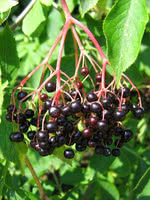Mon-Fri 9am - 5pm Mountain time
Bog Cranberry (Lingonberry) vs Black Elderberry
Vaccinium vitis-idaea
Sambucus canadensis
NOT AVAILABLE THIS SEASON - MIGHT RETURN
NOT AVAILABLE THIS SEASON - MIGHT RETURN
Bog Cranberry is a native, ground cover species. These plants generally produce one crop per year in summer. Plants may spread 3 feet in width forming a dense mat which makes it attractive as an ornamental ground cover.
Wild crops of Bog Cranberry are harvested each year in Newfoundland (more than 200,000 lbs/yr). Harvest of wild fruit can no longer keep up with demand. In Europe, 80 million pounds per year of this crop is grown or harvested from the wild.
Bog Cranberry flowers are similar in shape to those of blueberry and may be white or pink in color. These berries are considered to be highly flavored but not as tart as cranberries.
Check out our YouTube video of this plant in the fall: Fall Bog Cranberry.
Note: We use Bog Cranberry for Vaccinium vitis-idaea. This species is also known by many other common names. Please confirm the scientific name to ensure you are ordering the correct plant.
Black Elderberry is a deciduous shrub native to eastern North America. You can plant this shrub in moist areas and it will help stabilize your soil. You can also use it on rural properties anywhere you'd use a lilac.
Black Elderberries are considered to be partially self-pollinating. So while they will still produce some berries without cross-pollination, planting with another variety will increase yields. Consider planting with Ranch Elderberry or Bob Gordon Elderberry.
Warning: the seeds, stems, leaves, roots, and uncooked berries of the Black Elderberry are poisonous to humans when eaten in quantity. You should cook the berries to make them safe for human consumption.
Bog Cranberry (Lingonberry) Quick Facts
Black Elderberry Quick Facts
Toxicity: leaves, stems, and uncooked berries are poisonous to humans

